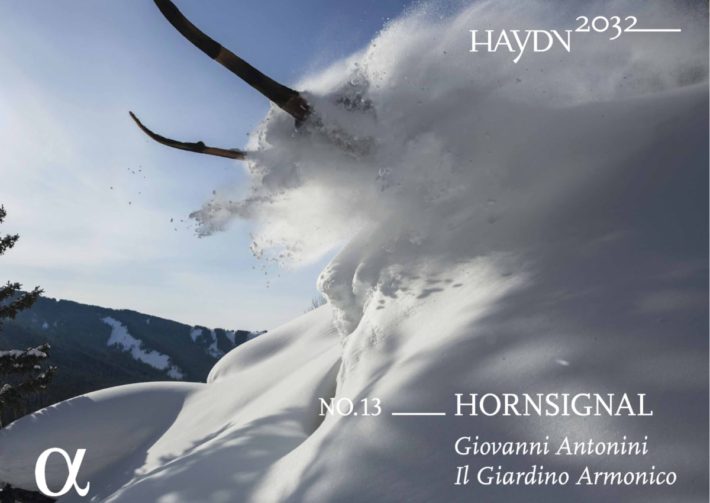The latest release in this ongoing Haydn symphony cycle focuses on three “horn-heavy” symphonies: No. 31, “Horn Signal”; No. 48, “Maria Theresia”; and No. 59, “Fire.” I last heard these three works in the reissued boxed set of Haydn symphonies, featuring the Academy of Saint Martin in the Fields under Neville Marriner (Eloquence). When first released, Marriner’s interpretations were considered ‘modern’ because of the quick tempos, clear articulation, and lighter orchestral textures. But these new (period instrument) performances reveal just how far historically informed performance has come.
Read all of our reviews of Antonini’s “Haydn 2032” series releases
The program opens with a brilliantly gregarious reading of Symphony No. 31, the four horns playing with remarkable swagger. Harnoncourt’s Concentus Musicus Wien has a similar level of brio, but Antonini inspires a more infectious energy. He sets a flowing tempo for the second movement, bringing out a variety of orchestral color and weight that ensures, despite taking every repeat, the movement never outstays its welcome. The Minuet is fast, roughly a minute quicker than Hogwood (Academy of Ancient Music/Decca), Marriner and Fey (Heidelberger Sinfoniker/Hänssler). These three readings have a polished civility, whereas this new reading has a gruff folksiness. The Finale is a witty set of seven variations, each of which shows off a particular instrument of section. Antonini shapes the music with a sure hand, his soloists full of character, leading into a presto coda capped off by those brazen horns.
The performance of Symphony No. 59 is similar, Antonini’s first movement not any faster than Hogwood, Harnoncourt or Pinnock (The English Consort/Archiv), but with an extra exuberance. Il Giardino Armonico’s players seem to relish their heterogenous coloring, while the English orchestras under Hogwood and Pinnock deliver a rounded, homogenous sound. The second movement is again quicker than most other readings, and at this point I began to feel the tempos have a certain relentlessness. While the agility and athleticism of the playing heard here is always impressive, Harnoncourt and Brüggen (Orchestra of the 18th Century/Philips) find a greater range of emotions. The following Menuetto is playful and lightly articulated, while in the Finale the horns again take center stage. Their articulation, especially in trills, is slightly muddy compared to their English Consort and Orchestra of the 18th Century counterparts.
Related Posts
- Review: Haydn – Die Schöpfung (The Creation) – Antonini
- Review: “All Shall Not Die” – Haydn String Quartets – Quatuor Hanson
- Haydn – A Beginners Guide
The opening of Symphony No. 48 is perfect, fast but not overly driven. Haydn’s orchestra did not have trumpets, so to create a trumpet sound, he asks his horns to play in C-alto, which sounds an octave higher than was normal. Il Giardino Armonico’s horns make it sound deceptively easy. The Adagio is beautifully dispatched, though Brüggen’s slightly slower tempo finds a more pliant sweetness and greater emotional contrast. The last two movements have plenty of panache.
Two aspects of the recording struck me as anomalous. First, previous volumes in this series usually include music by other composers that give the listener another prism through which to appreciate Haydn’s works. This album includes Telemann’s ‘Concerto for Recorder and Horn’ (TWV 42: F14), which is pleasant enough, but I fail to see its connection with the rest of the program (surely not the use of a solo horn?).
Secondly, Antonini’s introductory note does not discuss the repertoire heard on this album, but instead gently rebukes a journalist’s criticism of his tempo choice for the first movement of Symphony No. 69 (performed on Volume 12). While the tempo discussion proves informative, it is disconcerting to have what is, in essence, a ‘letter to the editor’ about music recorded on another album.
Perhaps this inconsequential issues stood out because, in the main, these new performances maintain the excellence of the previous volumes. Liner notes and artwork are excellent, and the engineered sound has clarity and warmth, even if, especially in Symphony No. 31, the horns threaten to overwhelm the rest of the orchestra.

Haydn 2032, Vol. 13 – “Horn Signal“
Symphonies 31, 48, 59
Il Giardino Armonico
Giovanni Antonini – Conductor
Alpha, CD 692
Recommended Comparisons
Read more classical music reviews or visit The Classic Review Amazon store
Follow Us and Comment:
Get our periodic classical music newsletter with our recent reviews, news and beginners guides.
We respect your privacy.








